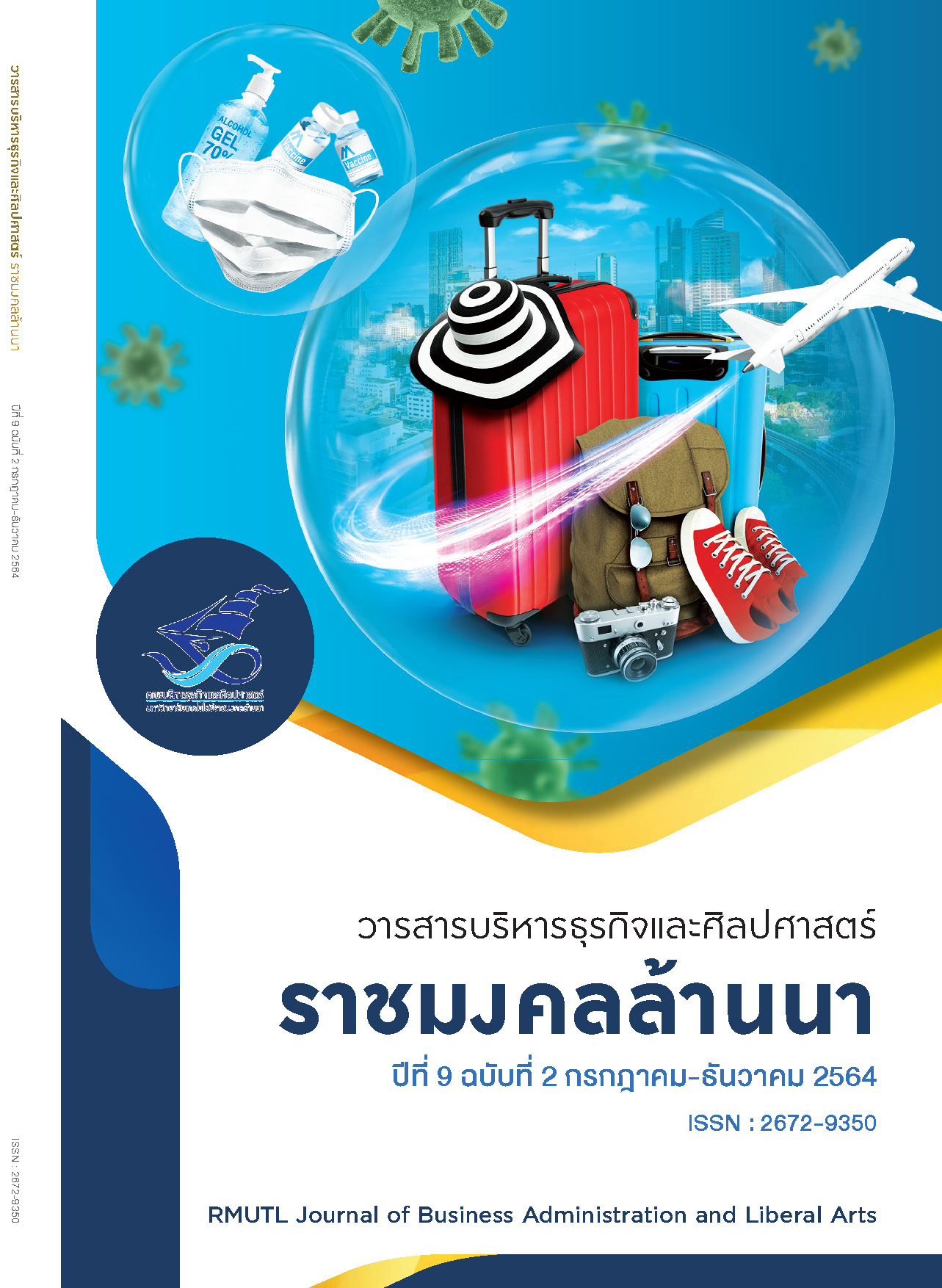Effect of Risk Management toward Survival of Small Hotel Businesses in Lampang Province
Main Article Content
Abstract
This research was a quantitative research. The objectives were (1) to study the opinion level of risk management and business survival and (2) to test the impact of risk management on the survival of small hotel businesses in Lampang Province. The population was small hotel businesses in Lampang province with 99 samples. The tool was a questionnaire collected from executives or entrepreneurs of small hotel businesses in Lampang Province. The statistics used in the research were descriptive statistics for percentage, mean, and standard deviation. In addition, inference statistics used to analyze data were multiple regression analysis.
The results of the research were found that 1) overall and individual risk management were averaged at a high level, i.e. integrated risk assessment the ease of Comprehensive reporting, Holistic Risk Planning and systematic monitoring. 2) The overall and individual business survival mean was at a high level, i.e. the potential for adaptation to change the ease of sustainable competitive, advantage, and the effectiveness of the organization dynamics and 3) the results of testing the impact of risk management on the survival of the business found that the systematic monitoring control, holistic risk planning, and comprehensive data reporting had a positive impact on the survival of small hotel businesses in Lampang.
Therefore, entrepreneurs must focus on managing business risks and sticking to the principles of business identity preservation because it is a small business and there are limitations to increasing income. This causes entrepreneurs to look carefully at the risks under the clear strengths of the business. When there is a problem with business operations, the business can continue to be stable.
Article Details

This work is licensed under a Creative Commons Attribution-NonCommercial-NoDerivatives 4.0 International License.
บทความวิจัยนี้เป็นของลิขสิทธิ์
References
กองเศรษฐกิจการท่องเที่ยวและกีฬา. (2563). สถานการณ์ด้านการท่องเที่ยวเดือนธันวาคม พ.ศ. 2562. สืบค้น 27 เมษายน 2564, จาก https://www.mots.go.th/download/article/article_20200123132729.pdf.
จิรพร สุเมธีประสิทธิ์. (2563). Business Risk – การบริหารความเสี่ยงทางธุรกิจต้องเข้มข้นมากขึ้น – เรื่องที่ 340. สืบค้น 27 เมษายน 2564, จาก https://chirapon.wordpress.com/tag/ความเสี่ยงทางธุรกิจ.
ญาณิศา เผื่อนเพาะ. (2562). การจัดการความเสี่ยงในธุรกิจขนาดกลางและขนาดย่อม. วารสารวิทยาการ จัดการปริทัศน์, 21(1), 191-199.
ตลาดหลักทรัพย์แห่งประเทศไทย. (2547). แนวทางการบริหารความเสี่ยง (ฉบับปรับปรุง). กรุงเทพฯ: ตลาดหลักทรัพย์แห่งประเทศไทย.
มงคล กิตติวุฒิไกร และมนัสดา ชัยสวนียากรณ์. (2558). ผลกระทบของการบริหารความเสี่ยงที่มีผลต่อความสำเร็จในการทำงานของธุรกิจ SMEs ในจังหวัดมุกดาหาร. วารสารมนุษยศาสตร์และสังคมศาสตร์, 6(1), 105-118.
วรรษพร ผิวดี. (2555). การศึกษาการจัดการความเสี่ยงของธุรกิจโรงแรมและรีสอร์ท จังหวัดกระบี่. กรุงเทพฯ: มหาวิทยาลัยธุรกิจบัณฑิตย์.
วรัญญา เยาวรัตน์ ลี. (2560). ปัจจัยสาเหตุที่ส่งอิทธิพลต่อการพัฒนาเพื่อความอยู่รอดขององค์การธุรกิจในประเทศไทย.(ปริญญานิพนธ์ปริญญาดุษฎีบัณฑิต). ชลบุรี: มหาวิทยาลัยบูรพา.
ศูนย์วิจัยเศรษฐกิจ ธุรกิจและเศรษฐกิจฐานราก ธนาคารออมสิน. (2562). ธุรกิจโรงแรม. สืบค้น 7 ตุลาคม 2562, จาก https://gsb.or.th/getattachment/2d71f78d-6d9a-4e68-934f-3c88a9aa4b73/hotel_11_61.aspx.
สำนักงานสถิติจังหวัดลำปาง. (2559). สถานการณ์การท่องเที่ยวจังหวัดลำปาง. สืบค้น 7 ตุลาคม 2562, จาก http://lampang.nso.go.th/index.php?option=com_content&view=article&id=273:2018-08-08-09-23-45&catid=105:2012-01-09-07-07-49&Itemid=657.
สำนักงานส่งเสริมวิสาหกิจขนาดกลางและขนาดย่อม. (2562). พระราชบัญญัติโรงแรม พ.ศ. 2547. สืบค้น 7 ตุลาคม 2562, จาก https://www.dip.go.th/Portals/0/patuemoh/fatu/.
สิริรัตน์ เกวียนเจริญกุล. (2555). ปัจจัยที่มีผลต่อการบริหารความเสี่ยงทั่วทั้งองค์การของธุรกิจโรงแรมในประเทศไทย. อุบลราชธานี: มหาวิทยาลัยอุบลราชธานี.
วนิดา รักความสุข. (2562). แนวทางการจัดการความเสี่ยงและการบริหารการจัดการอย่างยั่งยืนของธุรกิจ โฮสเทลในเขตจังหวัดชลบุรี. ชลบุรี: วิทยาลัยพาณิชย์ศาสตร์ มหาวิทยาลัยบูรพา.
สำนักงานสถิติแห่งชาติ. (2559). สำรวจการประกอบกิจการโรงแรมและเกสต์เฮ้าส์ พ.ศ. 2559. สำนักงานสถิติแห่งชาติ กระทรวงดิจิทัลเพื่อเศรษฐกิจและสังคม.
Althonayan, A., Keith, J. & Misiura, A. (2011). Aligning Enterprise Risk Management with Business Strategy an Information System. European, Mediterranean & Middle Eastern Conference on Information Systems 2011. May 30-31, 2011.
Barney, J. (1991). Firm Resources and Sustained Competitive Advantage. Journal of Management, 17, 99-120.
COSO (2004). Enterprise Risk Management- Integrated Framework: Application Techniques 1-105.
Gujarati, D.N. , & Porter, D.C. (2009). Basic Econometrics (5th Edition). New York: McGraw Hill.
Hair, J.F., Black, W.C., Babin, B.J., & Anderson, R.E. (2010). Multivariate Data Analysis (7th ed.). New York: Pearson.
Marlena, B. (2004). Risk control methods in a hotel operation. The Poznań University of Economics. https://www.academia.edu/5105962/Risk_control_methods_in_a_hotel_operation.
Marquardt, M. J. (1996). Building the Learning Organization: A System Approach to Quantum Improvement and Global Success. New York: McGraw-Hill.
Njagi, C. G. (2016). The effects of risk management practices in performance of hotel in Mombasa county (Master of Science in Finance). Kenya: University of Nairobi.
Porter, M.E. (2005). The Competitive Advantage Creating and Sustaining Superior Performance. New York: The Free Press. 4.
Robbins, S. P. (2011). Organization behavior (15th ed.). Upper saddler river, NJ: Prentice Hall.
Steers, R. M. (1977). Organization Effectiveness. California: Goodyear Publishers.
Wade, V. M. (2006). Likert-type scale response anchors. Clemson International Institute for Tourism & Research Development, Department of Parks, Recreation and Tourism Management. Clemson University.
Ray, G., Barney, J. B., & Muhanna, W. A. (2004). Capabilities, business processes, and competitive advantage: Choosing the dependent variable in empirical tests of the resource-based view. Strategic Management Journal, 25(1), 23-37.
Grant, R.M. (1991) The Resource-Based Theory of Competitive Advantage. California Management Review, 33, 114-135.
Wernerfelt, B. (1984) The Resource-Based View of the Firm. Strategic Management Journal, 5, 171-180.

